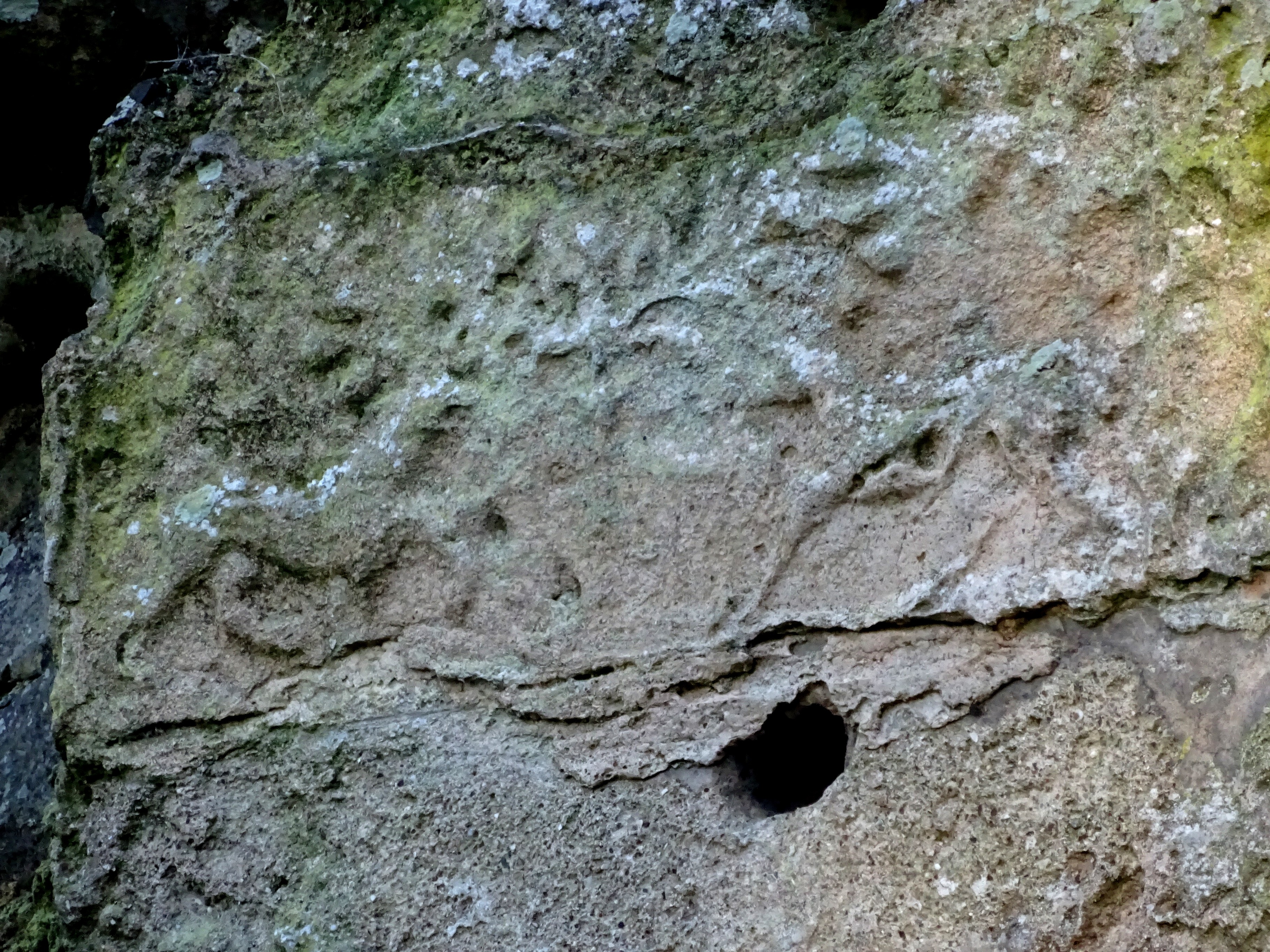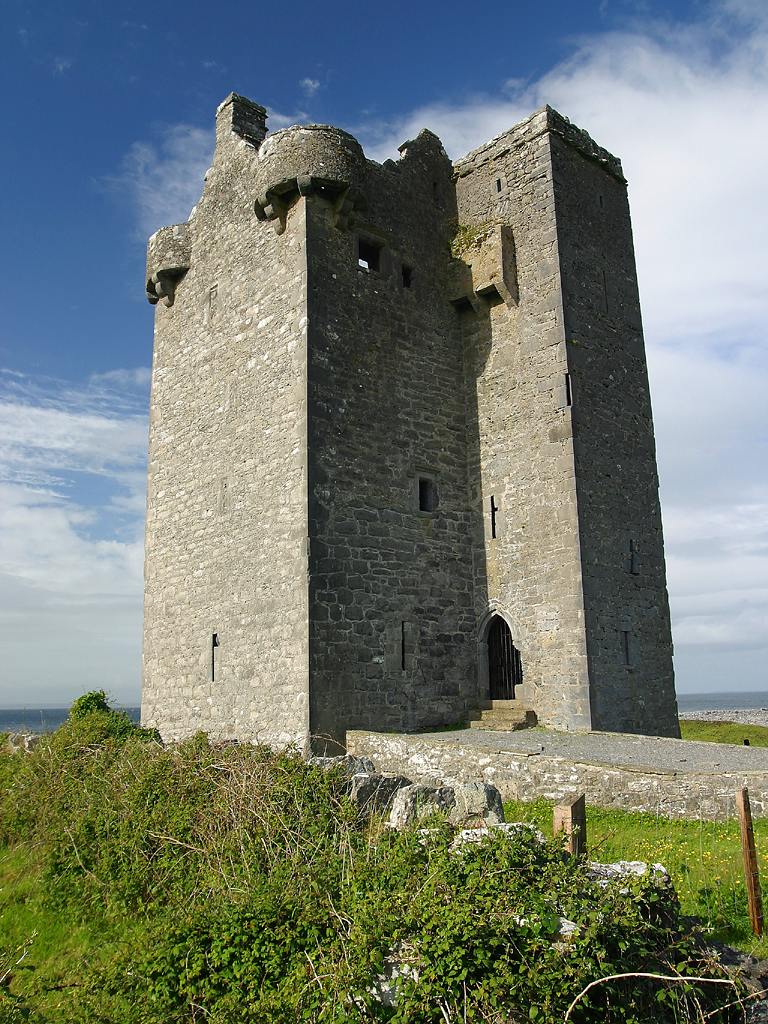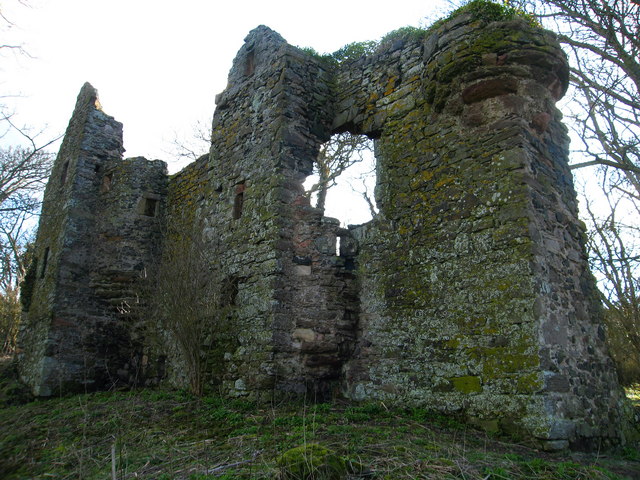|
Auldhame Castle
Auldhame Castle is a ruined L-plan tower house standing on a ridge above Seacliff beach, about 3 miles east of North Berwick in East Lothian, and less than half a mile from Tantallon Castle. Description The castle was built in the 16th century, probably by Adam Otterburn of Reidhall, Lord Provost of Edinburgh. It consists of a three-storey main block with a projecting stair-tower. Part of a vaulted basement kitchen remains, with a bread oven. The upper floors are mostly gone. Some plaster remains on the walls, including traces of a moulded decorative frieze. Archaeological excavation One of the three supposed corpses of Saint Baldred of Tyninghame was said to have been buried at the site in 756. A cemetery site in an adjoining field was excavated in 2008, the remains of at least 326 individual skeletons were noted, plus the foundations of a probable chapel with an estimated 9th century date (based on comparisons with similar structures). See also *List of castles in Scotland ... [...More Info...] [...Related Items...] OR: [Wikipedia] [Google] [Baidu] |
Auldhame Castle
Auldhame Castle is a ruined L-plan tower house standing on a ridge above Seacliff beach, about 3 miles east of North Berwick in East Lothian, and less than half a mile from Tantallon Castle. Description The castle was built in the 16th century, probably by Adam Otterburn of Reidhall, Lord Provost of Edinburgh. It consists of a three-storey main block with a projecting stair-tower. Part of a vaulted basement kitchen remains, with a bread oven. The upper floors are mostly gone. Some plaster remains on the walls, including traces of a moulded decorative frieze. Archaeological excavation One of the three supposed corpses of Saint Baldred of Tyninghame was said to have been buried at the site in 756. A cemetery site in an adjoining field was excavated in 2008, the remains of at least 326 individual skeletons were noted, plus the foundations of a probable chapel with an estimated 9th century date (based on comparisons with similar structures). See also *List of castles in Scotland ... [...More Info...] [...Related Items...] OR: [Wikipedia] [Google] [Baidu] |
Auldhame Castle Plaster Freize
Auldhame and Scoughall are hamlets in East Lothian, Scotland. They are close to the town of North Berwick and the village of Whitekirk, and are approximately east of Edinburgh. Saint Baldred's legacy It is said that the 8th-century Christian missionary Saint Baldred had one of his bases at Auldhame, and through his influence the parish of Auldhame had significant influence in the development of Christianity in Scotland. His name also lives on in St Baldred's Church and St Baldred's Road in North Berwick. Following his death there was a dispute between the parishes of Auldhame, Tyninghame, and Prestonkirk, as to which should have his body. The story goes that by the advice of a Holy Man, they spent the night in prayer. In the morning three bodies were found, in all respects alike, each in its winding sheet, prepared for burial. To this day all three churches maintain Saint Baldred was buried within their walls. In 2005 skeletal and archaeological remains, thought to be ... [...More Info...] [...Related Items...] OR: [Wikipedia] [Google] [Baidu] |
L-plan
An L-plan castle is a castle or tower house in the shape of an L, typically built from the 13th to the 17th century. This design is found quite frequently in Scotland, but is also seen in England, Ireland, Romania, Sardinia, and other locations. The evolution of its design was an expansion of the blockhouse or simple square tower from the Early Middle Ages. As building techniques improved, it became possible to construct a larger building footprint and a more complex shape than the simple blockhouse tower. A more compelling motivation for the L plan was the ability to defend the entrance door by providing covering fire from the adjacent walls. This stratagem was particularly driven by the advent of cannon used by attackers. It was common for the union of the two wings to have very thick wall construction to support a major defensive tower in the union area. For example, the stone walls of Muchalls Castle in Scotland are over 14 feet thick at the ground level. Built in the 13t ... [...More Info...] [...Related Items...] OR: [Wikipedia] [Google] [Baidu] |
Tower House
A tower house is a particular type of stone structure, built for defensive purposes as well as habitation. Tower houses began to appear in the Middle Ages, especially in mountainous or limited access areas, in order to command and defend strategic points with reduced forces. At the same time, they were also used as an aristocrat's residence, around which a castle town was often constructed. Europe After their initial appearance in Ireland, Scotland, the Stins, Frisian lands, Basque Country (greater region), Basque Country and England during the High Middle Ages, tower houses were also built in other parts of western Europe, especially in parts of France and Italy. In Italian medieval communes, urban ''palazzi'' with a very tall tower were increasingly built by the local highly competitive Patrician (post-Roman Europe), patrician families as power centres during times of internal strife. Most north Italian cities had a number of these by the end of the Middles Ages, but few no ... [...More Info...] [...Related Items...] OR: [Wikipedia] [Google] [Baidu] |
Seacliff
Seacliff comprises a beach, an estate and a harbour. It lies east of North Berwick, East Lothian, Scotland. History The beach and estate command a strategic position at the mouth of the Firth of Forth, and control of the area has been contested through the ages. The beach and estate were used as a staging post for various raids on nearby Tantallon Castle from the 14th to the 17th century. Troops were also stationed here to prevent landings by the French during the Napoleonic Wars in 1798. Before bloodshed touched the area, the 8th century Christian missionary Saint Baldred was based in nearby Scoughall, and several features of the area have been named after him, such as "Ghegan Rock" (Churchman's Haven). In quieter times, the ownership of the estate has changed hands on several occasions. Seacliff House was built in 1750 by Robert Colt. It was later bought by George Sligo who in 1841 employed the famous Scottish architect David Bryce to build a new house in baronial style o ... [...More Info...] [...Related Items...] OR: [Wikipedia] [Google] [Baidu] |
North Berwick
North Berwick (; gd, Bearaig a Tuath) is a seaside town A seaside resort is a town, village, or hotel that serves as a vacation resort and is located on a coast. Sometimes the concept includes an aspect of official accreditation based on the satisfaction of certain requirements, such as in the German ' ... and former royal burgh in East Lothian, Scotland. It is situated on the south shore of the Firth of Forth, approximately east-northeast of Edinburgh. North Berwick became a fashionable holiday resort in the nineteenth century because of its two sandy bays, the East (or Milsey) Bay and the West Bay, and continues to attract holidaymakers. Golf courses at the ends of each bay are open to visitors. Name The name Berwick means "barley farmstead" (''bere'' in Old English means "barley" and ''wic'' means "farmstead"). Alternatively, like other place names in Scotland ending in 'wick', this word means 'bay' (Old Norse: vík). The word North was applied to distinguish this Berw ... [...More Info...] [...Related Items...] OR: [Wikipedia] [Google] [Baidu] |
East Lothian
East Lothian (; sco, East Lowden; gd, Lodainn an Ear) is one of the 32 council areas of Scotland, as well as a historic county, registration county and lieutenancy area. The county was called Haddingtonshire until 1921. In 1975, the historic county was incorporated for local government purposes into Lothian Region as East Lothian District, with some slight alterations of its boundaries. The Local Government etc. (Scotland) Act 1994 later created East Lothian as one of 32 modern council areas. East Lothian lies south of the Firth of Forth in the eastern central Lowlands of Scotland. It borders Edinburgh to the west, Midlothian to the south-west and the Scottish Borders to the south. Its administrative centre and former county town is Haddington while the largest town is Musselburgh. Haddingtonshire has ancient origins and is named in a charter of 1139 as ''Hadintunschira'' and in another of 1141 as ''Hadintunshire''. Three of the county's towns were designated as roy ... [...More Info...] [...Related Items...] OR: [Wikipedia] [Google] [Baidu] |
Tantallon Castle
Tantallon Castle is a ruined mid-14th-century fortress, located east of North Berwick, in East Lothian, Scotland. It sits atop a promontory opposite the Bass Rock, looking out onto the Firth of Forth. The last medieval curtain wall castle to be constructed in Scotland,Lindsay, ''The Castles of Scotland'', p.440–442 Tantallon comprises a single wall blocking off the headland, with the other three sides naturally protected by sea cliffs. Tantallon was built in the mid 14th century by William Douglas, 1st Earl of Douglas. It was passed to his illegitimate son, George Douglas, later created Earl of Angus, and despite several sieges, it remained the property of his descendants for much of its history. It was besieged by King James IV in 1491, and again by his successor James V in 1527, when extensive damage was done. Tantallon saw action in the First Bishops' War in 1639, and again during Oliver Cromwell's invasion of Scotland in 1651, when it was once more severely damaged. I ... [...More Info...] [...Related Items...] OR: [Wikipedia] [Google] [Baidu] |
Adam Otterburn
Adam Otterburn of Auldhame and Redhall (died 6 July 1548) was a Scottish lawyer and diplomat. He was king's advocate to James V of Scotland and secretary to Mary of Guise and Regent Arran. The King's lawyer The law brought against the Douglas family Adam Otterburn was an important servant of the Scottish monarchy as a lawyer and a diplomat. In August 1524 Margaret Tudor sent him to England with the Earl of Cassilis and Scot of Balwearie to negotiate peace, and a possible marriage for James V with Princess Mary. In May 1525 the English ambassador Dr Thomas Magnus recommended him to Cardinal Wolsey for an annual pension of £20. In 1528 Magnus and Otterburn again discussed the possibilities of a marriage between James V and Princess Mary. When James V assumed the throne as an adult ruler and rejected the Douglases and their associates, Otterburn drew up charges of treason against them on 13 July 1529. On 8 November 1529 he was one of the Scottish commissioners who met English d ... [...More Info...] [...Related Items...] OR: [Wikipedia] [Google] [Baidu] |
List Of Lords Provost Of Edinburgh
The Right Honourable Lord Provost of Edinburgh is the convener of the City of Edinburgh local authority. They are elected by the city council and serve not only as the chair of that body, but as a figurehead for the entire city. They are also ex officio the Lord-Lieutenant of Edinburgh. They are equivalent in many ways to the institution of Mayor that exists in many other countries. While some of Scotland's local authorities elect a Provost, only the four main cities (Edinburgh, Glasgow, Aberdeen and Dundee) have a Lord Provost. In Edinburgh this position dates from 1667, when Charles II elevated the Provost to the status of Lord Provost, with the same rank and precedence as the Lord Mayor of London. The title of Lord Provost is enshrined in the Local Government etc. (Scotland) Act 1994. The current Lord Provost In total, there have been 256 Provosts and Lord Provosts. The current Lord Provost is Robert Aldridge. Past provosts of Edinburgh The first named individual o ... [...More Info...] [...Related Items...] OR: [Wikipedia] [Google] [Baidu] |
Baldred Of Tyninghame
Balthere of Tyninghame (later Baldred) was a Northumbrian hermit and abbot, resident in East Lothian during the 8th century. Dating According to Hovendeus the date of Baldred's death is given as 756. Symeon of Durham says "the twentieth year of King Eadberht of Northumbria " and Turgot of Durham "the seventeenth year of the episcopate of Cynulf", that is 756. As his feast is given as 6 March, by the modern calendar, this would be 6 March 757. Although the 8th century date is now generally accepted, due to a passage in the 16th century Breviary of Aberdeen, he has, in the past, often been associated with the 6th century Saint Kentigern. Life Baldred is commonly referred to as "the Apostle of the Lothians" and Simeon of Durham says that "the boundaries of his pastorate embraced the whole land which belongs to the monastery of Saint Balther, which is called Tyninghame - from Lammermuir to Inveresk, or, as it was called, Eskmouthe." His cult was certainly centred on the fou ... [...More Info...] [...Related Items...] OR: [Wikipedia] [Google] [Baidu] |
List Of Castles In Scotland
This is a list of castles in Scotland. A castle is a type of fortified structure built primarily during the Middle Ages. Scholars debate the scope of the word "castle", but usually consider it to be the private fortified residence of a lord or noble. This is distinct from a fortress, which was not a home, although this distinction is not absolute and the same structure may have had different uses from time to time. The term has been popularly applied to structures as diverse as hill forts and country houses. Over the approximately 900 years that castles were built, they took on a great many forms. In Scotland, earlier fortifications had included hill forts, brochs, and duns; and many castles were on the site of these earlier buildings. The first castles were built in Scotland in the 11th and 12th centuries, with the introduction of Anglo-Norman influence.Lindsay, Maurice (1986) ''The Castles of Scotland''. Constable. p.17 These motte and bailey castles were replaced with the fi ... [...More Info...] [...Related Items...] OR: [Wikipedia] [Google] [Baidu] |









